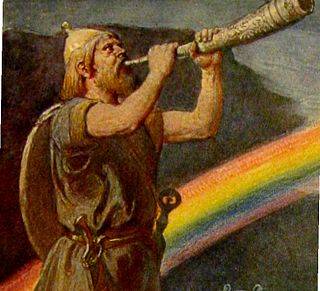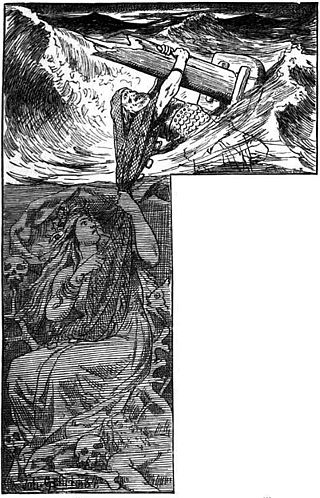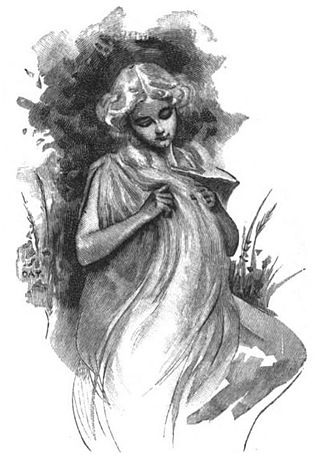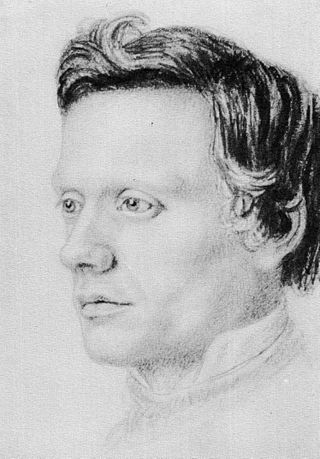
In Nordic mythology, Asgard is a location associated with the gods. It appears in a multitude of Old Norse sagas and mythological texts. It is described as the fortified home of the Æsir gods, often associated with gold imagery. Many of the best-known Nordic gods are Æsir or live in Asgard such as Odin, Thor, Loki, and Baldr.

Ægir, Hlér, or Gymir, is a jötunn and a personification of the sea in Norse mythology. In the Old Norse record, Ægir hosts the gods in his halls and is associated with brewing ale. Ægir is attested as married to a goddess, Rán, who also personifies the sea, and together the two produced daughters who personify waves, the Nine Daughters of Ægir and Rán, and Ægir's son is Snær, personified snow. Ægir may also be the father of the beautiful jötunn Gerðr, wife of the god Freyr, or these may be two separate figures who share the same name.

In Norse mythology, Bifröst, also called Bilröst, is a burning rainbow bridge that reaches between Midgard (Earth) and Asgard, the realm of the gods. The bridge is attested as Bilröst in the Poetic Edda; compiled in the 13th century from earlier traditional sources, and as Bifröst in the Prose Edda; written in the 13th century by Snorri Sturluson, and in the poetry of skalds. Both the Poetic Edda and the Prose Edda alternately refer to the bridge as Ásbrú.

In Norse mythology, Heimdall is a god. He is the son of Odin and nine mothers. Heimdall keeps watch for invaders and the onset of Ragnarök from his dwelling Himinbjörg, where the burning rainbow bridge Bifröst meets the sky. He is attested as possessing foreknowledge and keen senses, particularly eyesight and hearing. The god and his possessions are described in enigmatic manners. For example, Heimdall is emerald-toothed, "the head is called his sword," and he is "the whitest of the gods."

In Norse mythology, Rán is a goddess and a personification of the sea. Rán and her husband Ægir, a jötunn who also personifies the sea, have nine daughters, who personify waves. The goddess is frequently associated with a net, which she uses to capture sea-goers. According to the prose introduction to a poem in the Poetic Edda and in Völsunga saga, Rán once loaned her net to the god Loki.

In Norse mythology, Sif is a golden-haired goddess associated with earth. Sif is attested in the Poetic Edda, compiled in the 13th century from earlier traditional sources, and the Prose Edda, written in the 13th century by Snorri Sturluson, and in the poetry of skalds. In both the Poetic Edda and the Prose Edda, she is known for her golden hair and is married to the thunder god Thor.
Gymir is a jötunn in Norse mythology. He is the spouse of Aurboða, and the father of the beautiful jötunn Gerðr, who married the god Freyr. Gymir may be the same figure as Ægir, a personification of the sea or ocean, or a separate figure who shares the same name.
In Norse mythology, Níðhöggr is a dragon who gnaws at a root of the world tree, Yggdrasil. In historical Viking society, níð was a term for a social stigma, implying the loss of honor and the status of a villain. Thus, its name might refer to its role as a horrific monster in its action of chewing the corpses of the inhabitants of Náströnd: those guilty of murder, adultery, and oath-breaking.

In Norse mythology, the einherjar are those who have died in battle and are brought to Valhalla by valkyries. In Valhalla, the einherjar eat their fill of the nightly resurrecting beast Sæhrímnir, and valkyries bring them mead from the udder of the goat Heiðrún. The einherjar prepare daily for the events of Ragnarök, when they will advance for an immense battle at the field of Vígríðr.

Jörð is the personification of earth and a goddess in Norse mythology. She is the mother of the thunder god Thor and a sexual partner of Odin. Jörð is attested in Danish historian Gesta Danorum, composed in the 12th century by Danish historian Saxo Grammaticus; the Poetic Edda, compiled in the 13th century by an unknown individual or individuals; and the Prose Edda, also composed in the 13th century. Her name is often employed in skaldic poetry and kennings as a poetic term for land or earth.
Laufey or Nál[ˈnɑːl] is a figure in Norse mythology and the mother of Loki. The latter is frequently mentioned by the matronymic Loki Laufeyjarson in the Poetic Edda, rather than the expected traditional patronymic Loki Fárbautason, in a mythology where kinship is usually reckoned through male ancestry.

Máni is the Moon personified in Germanic mythology. Máni, personified, is attested in the Poetic Edda, compiled in the 13th century from earlier traditional sources, and the Prose Edda, written in the 13th century by Snorri Sturluson. Both sources state that he is the brother of the personified sun, Sól, and the son of Mundilfari, while the Prose Edda adds that he is followed by the children Hjúki and Bil through the heavens. As a proper noun, Máni appears throughout Old Norse literature. Scholars have proposed theories about Máni's potential connection to the Northern European notion of the Man in the Moon, and a potentially otherwise unattested story regarding Máni through skaldic kennings.
In Norse cosmology, svartálfar, also called myrkálfar, are beings who dwell in Svartalfheim. Both the svartálfar and Svartálfaheimr are primarily attested in the Prose Edda, written in the 13th century by Snorri Sturluson. Scholars have noted that the svartálfar appear to be synonymous with the dwarfs and potentially also the dökkálfar. As dwarfs, the home of the svartálfar could possibly be another description for Niðavellir.

Norse cosmology is the account of the universe and its laws by the ancient North Germanic peoples. The topic encompasses concepts from Norse mythology, such as notions of time and space, cosmogony, personifications, anthropogeny, and eschatology. Like other aspects of Norse mythology, these concepts are primarily recorded in the Poetic Edda, a collection of poems compiled in the 13th century, and the Prose Edda, authored by Icelander Snorri Sturluson in the 13th century, who drew from earlier traditional sources. Together these sources depict an image of Nine Worlds around a cosmic tree, Yggdrasil.

Guðbrandur Vigfússon, known in English as Gudbrand Vigfusson, was one of the foremost Scandinavian scholars of the 19th century.

In Norse mythology, Himinbjörg is the home of the god Heimdallr. Himinbjörg is attested in the Poetic Edda, compiled from earlier traditional sources, and the Prose Edda and Heimskringla, both written in the 13th century by Snorri Sturluson. Himinbjörg is associated with Heimdallr in all sources. According to the Poetic Edda, Heimdallr dwells there as watchman for the gods and there drinks fine mead, whereas in the Prose Edda Himinbjörg is detailed as located where the burning rainbow bridge Bifröst meets heaven. Scholars have commented on the differences between the two attestations and linked the name of the mythical location to various place names.

In Norse mythology, Líf and Lífþrasir, sometimes anglicized as Lif and Lifthrasir, female and male respectively, are two humans who are foretold to survive the events of Ragnarök by hiding in a wood called Hoddmímis holt and, after the flames have abated, to repopulate the newly risen and fertile world. Líf and Lífþrasir are mentioned in the Poetic Edda, which was compiled in the 13th century from earlier traditional sources, and the Prose Edda, written in the 13th century by Snorri Sturluson. Many scholars have speculated as to the underlying meaning and origins of both names.

Litr is the name borne by a dwarf and a jötunn in Norse mythology.

In Norse mythology, Sága is a goddess associated with the location Sökkvabekkr. At Sökkvabekkr, Sága and the god Odin merrily drink as cool waves flow. Both Sága and Sökkvabekkr are attested in the Poetic Edda, compiled in the 13th century from earlier traditional sources, and in the Prose Edda, written in the 13th century by Snorri Sturluson. Scholars have proposed theories about the implications of the goddess and her associated location, including that the location may be connected to the goddess Frigg's fen residence Fensalir and that Sága may be another name for Frigg.
These are family trees of the Norse gods showing kin relations among gods and other beings in Nordic mythology. Each family tree gives an example of relations according to principally Eddic material however precise links vary between sources. In addition, some beings are identified by some sources and scholars.













